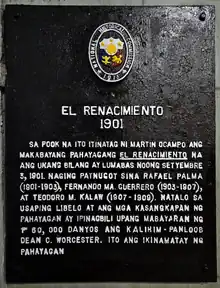%252C_p.4._(30_October_1908).jpg.webp) Scan of Page 4 of the Year 8, Number 49 issue of the newspaper containing the infamous editorial "Aves de rapiña" | |
| Type | Daily (except Sunday) |
|---|---|
| Founded | 1901 |
| Political alignment | Independent |
| Language | Spanish / Tagalog |
| Ceased publication | 1910 |
| Headquarters | 26 (Now ~340) Gunaw Street, Quiapo |
El Renacimiento (lit. 'The Renaissance') was a Spanish–Tagalog bilingual language newspaper. Spanish articles were published under El Renacimiento, while Tagalog articles were published under Muling Pagsilang. It was printed in Manila until the 1940s by the members of the Guerrero de Ermita family.
It was founded as a response to the signing of the Treaty of Paris, which derailed the Philippines' struggle for sovereignty.[1][2] It featured articles criticizing the United States' governance of the Philippines, including the policies of former U.S. President William Howard Taft.[3]: 397
The paper's publisher, Martin Ocampo, re-established it as the Spanish newspaper La Vanguardia and its Filipino edition Taliba on February 9, 1910 and February 19, 1910, respectively.[4]: 43, 58–59
Aves de rapiña

On October 30, 1908, El Renacimiento published a Spanish-language editorial entitled "Aves de rapiña" ("Bird of prey"), which dealt with corruption in the colonial government.
On January 23, 1909, the newspaper was sued for libel by Dean Conant Worcester, then-secretary of the interior of the Insular Government of the Philippines.[5][3]: 426 Worcester felt he was alluded to by the description of someone who had "the characteristics of the vulture, the owl and the vampire."[5] According to historian Ambeth Ocampo, Worcester allegedly used his position as interior secretary to profit from the sale of diseased beef. He was also alleged to have profited from overpriced hotel concessions on government land.[6]
Worcester's lawsuit pushed the paper towards bankruptcy and subsequent closure.[3]: 413 Kalaw and Ocampo were sentenced to prison. The majority of the remaining editorial staff were absolved of their sentences after a series of appeals from 1910 to 1912.[5][7] However, Kalaw and Ocampo were given pardons in 1914 by Governor-General Francis Burton Harrison.[6]
The essay has become part of the required reading list in Philippine colleges.[6] El Renacimiento is remembered as an anti-colonial publication that fought for press freedom during the American colonial period.[6]
Known staff
- Martin Ocampo – Founder, Publisher[4]: 43
- Rafael Palma – Founder,[4]: 43 Director (1901–1903)[lower-alpha 1]
- Fernando Ma. Guerrero – Director (1903–1907)[lower-alpha 1][4]: 43
- Teodoro M. Kalaw – Director (1907–1909)[lower-alpha 1][8]
- Lope K. Santos – Director for Muling Pagsilang[3]: 412
- Fidel A. Reyes – Chief Editor (ca.1908)[lower-alpha 2][7]
- Faustino Aguilar – Chief Editor[9]
- Wenceslao Retana – Editor[10]
- Javier Gomez de la Serna[3]: 413
- Dominador Gomez – Editor [3]: 413
- Isabelo de los Reyes – Editor[3]: 413
- Felipe Calderon – Editor[3]: 413
References
- ↑ Gregorio, Ferdinan S. (September 4, 2012). "In Defense of Freedom: Philippine Press Through the Ages". National Historical Commission of the Philippines. Retrieved June 7, 2020.
- ↑ "Rafael Palma". Senate of the Philippines. Retrieved June 7, 2020.
- 1 2 3 4 5 6 7 8 Cano, Gloria (December 2011). "Filipino Press between Two Empires: El Renacimiento, a Newspaper with Too Much Alma Filipina" (PDF). Southeast Asian Studies. 49 (3) – via Kyoto University Research Information Repository.
- 1 2 3 4 Taylor, Carson (1927). History of the Philippine Press. Manila, Philippines. Archived from the original on July 13, 2017.
{{cite book}}: CS1 maint: location missing publisher (link) - 1 2 3 Dean C. Worcester v. Martin Ocampo, et al., G.R. No. 5932 (Supreme Court of the Philippines February 27, 1912).
- 1 2 3 4 Ocampo, Ambeth R. (August 2, 2019). "'Birds of Prey'". Inquirer. Retrieved 2020-06-07.
- 1 2 Dean C. Worcester v. Martin Ocampo, et al., G.R. No. L-5527 (Supreme Court of the Philippines December 22, 1910).
- ↑ Buhain, Dominador D. (1998). A History of Publishing in the Philippines. Quezon City, Philippines: Rex Bookstore, Inc. p. 28. ISBN 9789712323249. Archived from the original on June 15, 2023.
- ↑ El Renacimiento. Collection 9.14. Miguel de Benavides Library, University of Santo Tomas.
- ↑ Schumacher, John N. (October 1962). "Wenceslao E. Retana: An Historiographical Study". Philippine Studies. 10 (4): 561. JSTOR 42719798. Archived from the original on June 15, 2023 – via JSTOR.
Notes
- 1 2 3 Years active are according to the historical marker of El Renacimiento placed by the National Historical Commission of the Philippines. The marker description uses the title patnugot, which can be translated as either editor or director.
- ↑ During the libel case, Reyes was identified as the chief editor, or redactor jefe at the time "Aves de Rapiña" was published.